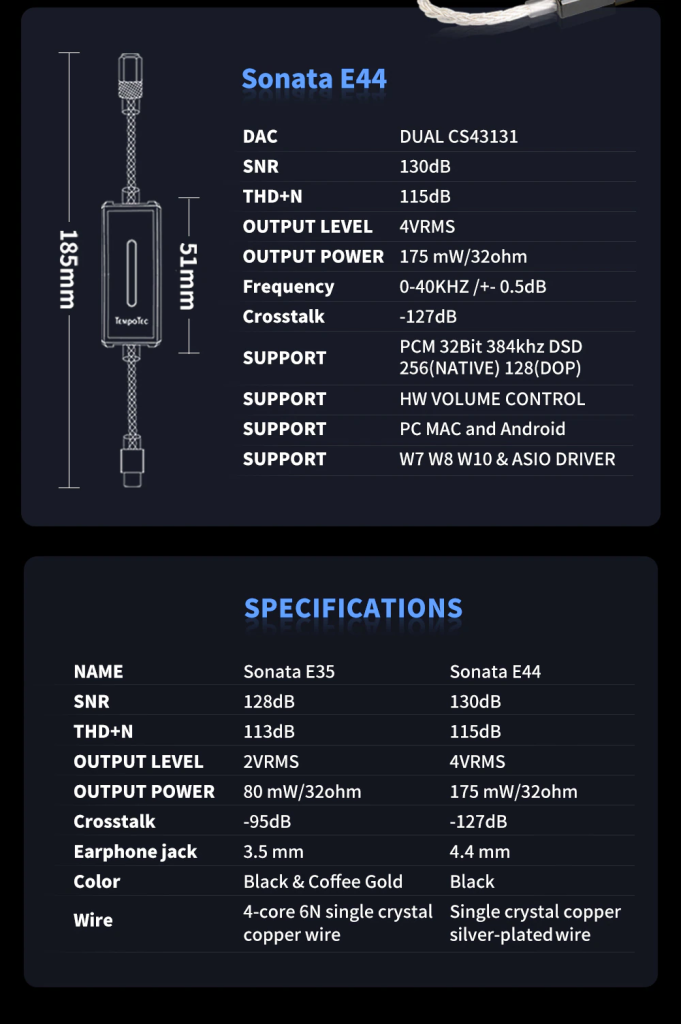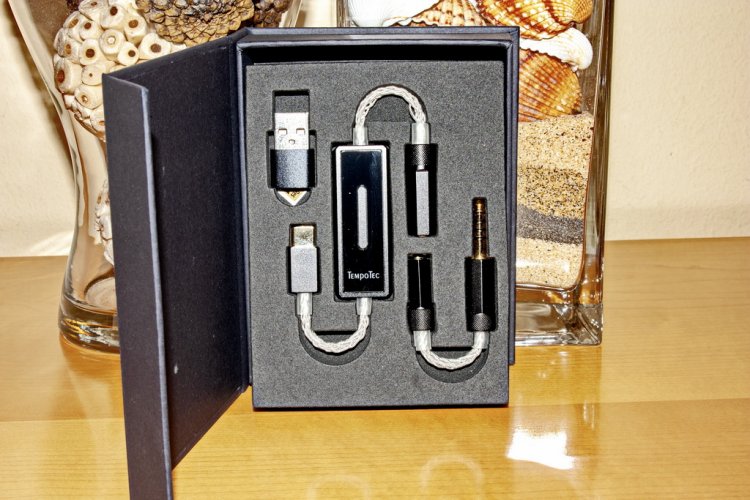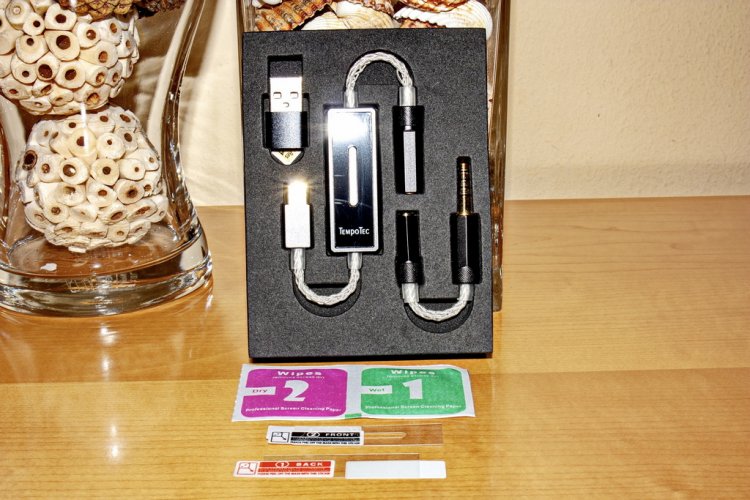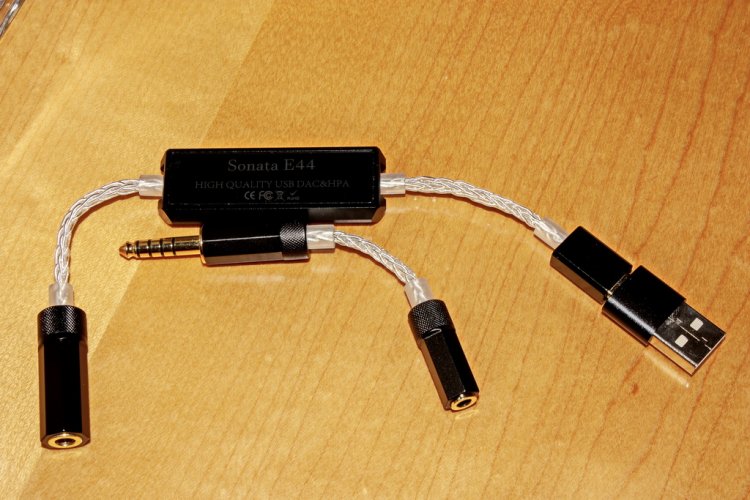
TONALITY: 8.5/10
TECHNICALITIES: 9/10
CONSTRUCTION: 8/10
SOUND VALUE: 9/10
TEMPOTEC is a chinese audio company specialize in portable DAC-AMP. They have collaborate in the past as OEM DAC-AMP company for company like Hidizs but decide to fly with their own wings and create their own ultra value budget DAC-AMP.
Tempotec get on the map with their 3 years old best seller, the HD PRO, which use a single cirrus CS43131 and cost 40$. AT the time, it was head and shoulder above all other hifi dongle offering in term of sound quality value and even today it stay very competitive.
Since HD PRO, they have launch alot of new dongle, most of them using dual CS43131 DAC like the BHD, E35 and the one I will review today, the E44.
Priced 80$, the E44 can be considered as the flagship dongle from this company. It use dual CS43131 DAC and have a 4.4mm balanced output. Let see if it’s a notable upgrade from the marvellous HD PRO (and HD V) in this review.

CONSTRUCTION

The E44 have an atypical design, firstly its cabled in both way, and the 4.4mm plug is near as big as dongle body. This body is made of metal and glass and is very thin. It have a volume control button. The cable material seem to be 6 cores silver plated and feel quite sturdy. To go back at this big 4.4mm plug, it’s heavier than the dongle itself too. The goal of this design is to make dongle more flexible, acting like a prolongation of earphones cable.

It make about 3 months I have this dongle and durability seem very nice. Everything feel premium with teh E44, even USB C connector which have thick metal body. 4.4mm is heavy as said and made of thick metal, it’s gold plated as well. Cable of both end seem not sensible to pulling stress and promise long durability too.

One notable drawback about design is the volume control, and this for multiple reason. Firstly it can’t be use in exclusive mode as single volume control, secondly it only have 32 steps, and thirdly the single long button is sensible to pressing and when you hold it it scale very fast in volume step. This mean i get my ears explode at least 10 times, it happen when i walk with the E44+phone in my pocket which can press button with phone weight pressing the long button…since the E44 can play VERY loud, this can be dangerous for hearing no doubt. In that regards, Tempotec BHD have better button, less prompt to easy pressure.
In term of packaging, it’s very minimalist and don’t even worth picture (ok, i lost the box and some accessories, this is why there no pics!). Its a small box wich include an extra 3.5mm female to 4.4mm male adapter, a USB-C to USB adapter, protective screen, wipe cloth and a much need Hi-Res sticker to stick on your cat or anything you find funny to transform into hifi product. All in all, we have everything we need here so no complaint.
AMPING

At 4vrms, the E44 deliver a very respectable 180mw@32ohm which will be plenty enough power for 95% of IEM, earbuds and headphones. Top put in perspective, it’s 3 times more powerfull than the HD PRO. With a rather low level of total harmonic distortion, it deliver a clean and hiss free loud amping experience.
It seem Tempotec choose to use implemented amping section of CS43131 DAC in dual mode, but i’m really not certain. Still a single DAC deliver 2vrms, double it and it equal 4vrms….but for the rest, its mystery to me.
Still, i can certainly conclude it really deliver 180mw@32ohm since it one of the most powerfull dongle I own out of 20. I wouldn’t say it’s as clean or linear as THX AAA amp, nor as transparent, yet it’s crisp, with black background and great dynamic scale-something that I favor in amping factor, being able to feel difference in notes loudness and impact.
Clipping is very rare but can occur with very hard to drive IEM like the Final Audio E5000 when you pass certain volume level. This will translate in bass distortion, especialy sub bass heavy track, not so much with instrumental music. And even pricier Questyle M15 create this, but in a smoother way.
SOUND IMPRESSIONS

I would call the slight tonality push as gently bright neutral to well rounded W shape. It’s energic and fowards presentation, yet, holographic and not harsh or agressive nor grainy or spiky. Hint of mid bass extra punch authorit, hint of extra upper mids bite and mid+upper treble snap. The balance feel natural, not forced, yet the dynamic is lively and engaging.
Since it’s not lean and cold sounding but feel it have hint of W shape dynamic heft to overall tonal balance, I can’t consider the E44 plain neutral. It’s injected with lush musicality, yet have a vivid clean and detailed rendering. Nothing feel distant with the E44, you have an holographic perception of fowards bass, mids and treble, all in their presence and body. Well rounded and full bodied tonality that sit between mature analytical and lush musical. Crisp L shape come to mind due to beefy low end. A unique yet cohesive mix of warm bass impact, bright clear mids and highly detailed treble without the CS43131 extra air spike we can expect from this DAC.
The E44 tend to add a bit of texture and punch to the mid bass, which is very notable with the Moondrop Aria, but what it do to this IEM is taming a bit the sub bass resonance and rumble, keeping it’s presence cleaner, more texture and tactile than physical. Yet kick drum sound more rounded with magnify layering, in the sens sub bass and kick doesn’t mix togheter but sit on each other in a neutral way. Don’t get me wrong, we never feel lacking sub bass, it just become less loose and more controlled with the E44, and the slam become tighter, rounder, less bleedy too.
When it come to mids, transition is smooth and dynamic have weight. Definition is detailed and clean, yet not edgy or clinical. It’s not the widest in presence, it centered and well sculpted in instrument singularity. Transparency is good but texture do make timbre a bit opaque. Timbre is quite dense tough, not thin like lot of other CS43131 dongle i try. Between lush and bright. Free of sibilance boost.
The treble is superb, even if it trade some sparkle and air to achieve this impressive timbral balance that feel so natural yet near analytical in it’s richness. Percussions have this 3D feel to them, in the sens it’s fully extract, not half done with faked sharpness or over boosted brilliance. You have full image of sound reconstitution here. And alot of micro-details to discover too. About brilliance and sparkle, it just don’t boost it, but will not tame it if your IEM produce some. Fact is that everything is organically balanced, yet with sharp but not spike definition.
The spatiality is a bit stretched in wideness-tallness and doesn’t blur deepness, so it tend to feel more holographic and fully presented in a 180 degree, not just stereo since center stage is perceive too.
Imaging is very impressive and better than the excellent Xduoo Link2 Bal in that regard since it’s cleaner in layering. You have both good separation of wide sound layers and pin point perception of static instrument, it’s precise without feeling forced or analytical and you can dig trough sound layers transparency even if their are richly textured.
PAIRING

With FINAL AUDIO E5000
This is a very hard to drive IEM due to low sensitivity, which is different than impedance and can even be more capricious in proper amping.
Firstly, good news, the E5000 sound open, have improved resolution and brighter mids and treble. Unfortunately, when it come to bass, we can have clipping-distortion at high volume and overall body isn’t as well rounded, warm and thick too, still, i do listen at unhealty high volume.
Let just say the fact E44 can properly drive the E5000 is extremely impressive, the sound is open, with more spacious imaging, faster attack punch and snap, timbre is still lush and natural yet with a hint of extra energy that permit cleaner mids presentation, which with warm dac-amp will make the E5000 sound overly dark and warmed by bass.
Simply put, unless if cranked at max volume to ears exploding level, this pairing is excellent and improve technical performance of the Final E5000 gloriously.
With MOONDROP ARIA
Ok, this is a great pairing and far from boring for sure since it make the Aria sounding more foward and energic as well as more focus on texture. So, brighter mids and more mid bass textured, so bit of extra punch and bit of sub bass taming. Female vocal sound fuller and better extracted, more textured and foward, less laid back overall. Beautifull crispness of Aria is preserve, perhaps with a hint of extra abrasive bite…as if Aria begin a transformation to become a Kato. That surely proof how Aria are transparent to source, since here its tonality is more W shape than U shape. Very interesting and rewarding paring, with an injected sens of immediacy and holographic between lush and crisp rendering. Highly immersive and addictive!
With TINHIFI P1plus
Though less hard to drive than both Final E5000 and Tinhifi P1, I wouldn’t say these Planar IEM are easy to properly drive either, and again the E44 proof to deliver plenty of amping power, this time without clipping issue at max volume as the well define and articulate thick sub line of ”Moonlight” track from IAMDDB show, rumble stay clean even when i crank up volumeabove my already loud listening range. So, we have an open and deep spatiality, punchy bass and gently bright P1plus here, with vivid dynamic and again this energic snappy performance. It isn’t as sharp and treble crispness foward as with other CS43131 source like Tempotec HD PRO or BHD, very balanced sounding and rich in texture, where the P1plus can show every single micro-details. I wouldn’t say it’s my favorite pairing but sure a good one that can be resume: extra texture details and density, more energic less delicate dynamic, crunchier fuller treble.
COMPARISONS

VS FIIO KA3 (ES9032q2m DAC-80$)
So, the E44 have slightly lower power output, but it’s doesn’t translate into a lack of dynamic energy, which in fact is more weighty and lively in amplitude projection than KA3. This is surely due to dual DAC used that perhaps permit lower crosstalk.
(Indeed, I just check and E44 crosstalk is about 3 times lower.)
This doesn’t mean E44 sound clearer, but that dynamic is better articulated and sound projection perhaps more free since attack of KA3 is notably more retain and blend. In other words, high resolution of E44 doesn’t feel forced, while with KA3 it does, with extra grain that amplify brighness reveal.
Bass of E44 have bigger slam and warmer, fuller timbre, in fact here the timbre is very different, more natural and pleasant with E44, yet less amplify in texture and ”digital transparency”. Mids is where the KA3 show it’s more artificial tonality, it doesn’t open in wideness as much as E44 and make instrument like saxophone and some vocal notably more dry and thin and rude in realism. Finally ,treble is brighter and more agressive with the KA3 as expected, it have less natural brilliance and sparkle as well as resonance than E44.
Hum, here, the clear winner is Tempotec E44, even if technically it isn’t as ”frontal”, the dynamism is more coherent, hefty and fluidly articulated in contrast of amplitude than flatter colder more clinical sounding KA3.
VS XDUOO LINK 2 BAL (dual CS43131+independant amp chip-160$)
E44
DAC=Dual cirrus CS43131
Power output= 175mw@32ohm 4.4bal
SNR=130db
LINK2 BAL
DAC=Dual CS43131
AMP CHIP=LM27762
Power output=275mw@32ohm 4.4Bal 125mw Se
SNR=127db
These are a bit similar in tonal balance, not timbre nor spatiality presentation since BAL is more open, wide and tall. The independant amp section did inflict greatly to overall sound ,adding hint of warmth and density to individual instrument without affecting negatively the resolution.
Still, E44 feel more cold-clean, with an edge in definition that is more evident in busy messy music passage where BAL will have more harmonic distortion and blurry micro details. E44 hacve deeper spatiality and more precise instrument placement in a more restrain spatiality. Silence feel cleaner as well as background noise lower.
Something surprising too, is how the bass differ with those 2, BAL being notably weightier warmer and more beefy in slam due to extra sub bass presence. Sub bass have more density, rumble and mid bass is a bit less vivid in tight punch, less well separated from mids tooa nd more prompt to mix and thicken tonality.
To go back about timbre, which is biggest difference between those 2 after power output, E44 is thinner with greater transparency, a bit more polished less textured-grainy than BAL, vocal are a bit more lush, euphonic and appealing with BAL but not as well cleanly extracted in presence.
It’s evident to me that LINK2 BAL is more about amping power upgrade than proper sound quality upgrade, since its really more about timbre and slightly warmer more analogish tonality which can be usefull for brighter IEM or power hungry ones like the Final A8000 I use, but still, if you plan to only use balanced output on it, im not sure you need this extra 100mw the extra amping section deliver. Why? Because it had hint of harmonic distortion, which will inflict technical performance in term of attack sustain, snap and overall resolution. We are in tonality subjectivity for this case. Some will swear that BAL is better when in fact they find musicality more charming, thats all. Oh, and i check the SNR after this comparison….interesting isn’t it that E44 is better in that regard?
CONCLUSION

Even if it’s more than 6 months old, the E44 still is a very competitive dongle that stand it’s ground in the overwhelming dongles offering of today portable audio.
Tempotec implementation of dual CS43131 DAC is excellent here, delivering a natural cohesive tonality that is highly resolved yet highly musical too.
With it’s high power output, black noise floor, above average technical performance and affordable price, the E44 offer high sound value that is versatile in both power and tonality.
Tempotec haven’t finish to surprise us, so stay tuned for their upcoming mid-tier Android DAP too, it will use dual AK4493SE DAC and have alot of features. I mean ALOT!
———–
PS: I want to thanks Tempotec for sending me this review sample. Though i’m a big fan of Tempotec since 4 years, it doesn’t bias my sound impressions and i’m not affiliated or compensate financially by this great audio company.
You can order the Tempotec E44 from their official store HERE
Or on Hifigo store HERE
For more honest reviews of diversify audio products, give a read to my No Borders Audiophile blog HERE.

































 Electric current is also very tiny and 2.5mm plug/socket is way above needs. Here is cable what I made by myself. I'm using Canare Starquad l-4e5c conductor unfortunely with E1DA 9038S G3 Susumu 3000 because of detachable cable (fixed in E44 is con in my opinion) and 2.5mm mobile connection standard. That is also only my opinion
Electric current is also very tiny and 2.5mm plug/socket is way above needs. Here is cable what I made by myself. I'm using Canare Starquad l-4e5c conductor unfortunely with E1DA 9038S G3 Susumu 3000 because of detachable cable (fixed in E44 is con in my opinion) and 2.5mm mobile connection standard. That is also only my opinion  Have a good day !
Have a good day !

On the other hand, if you don't want to use your phone or pc buy a DAP.